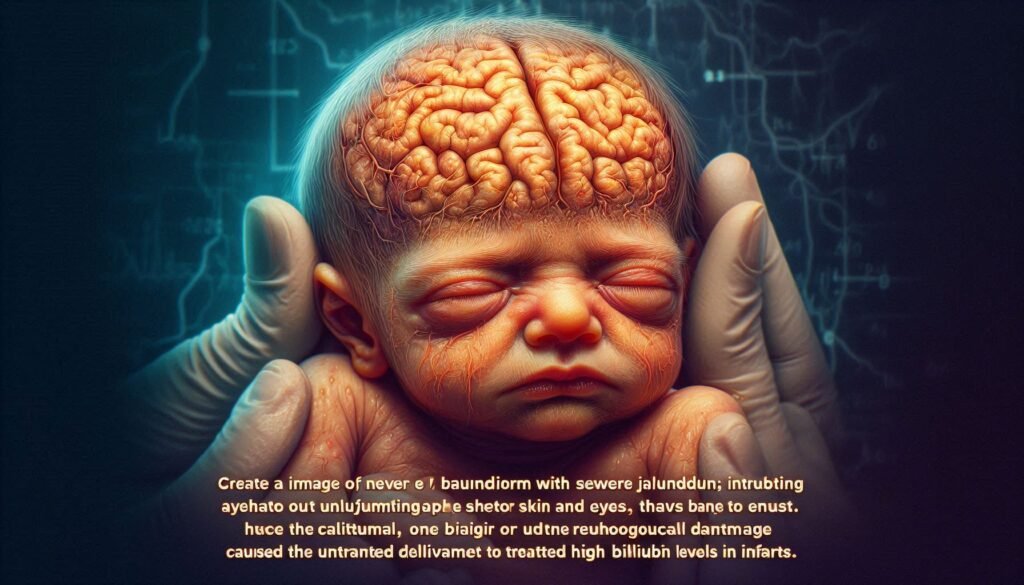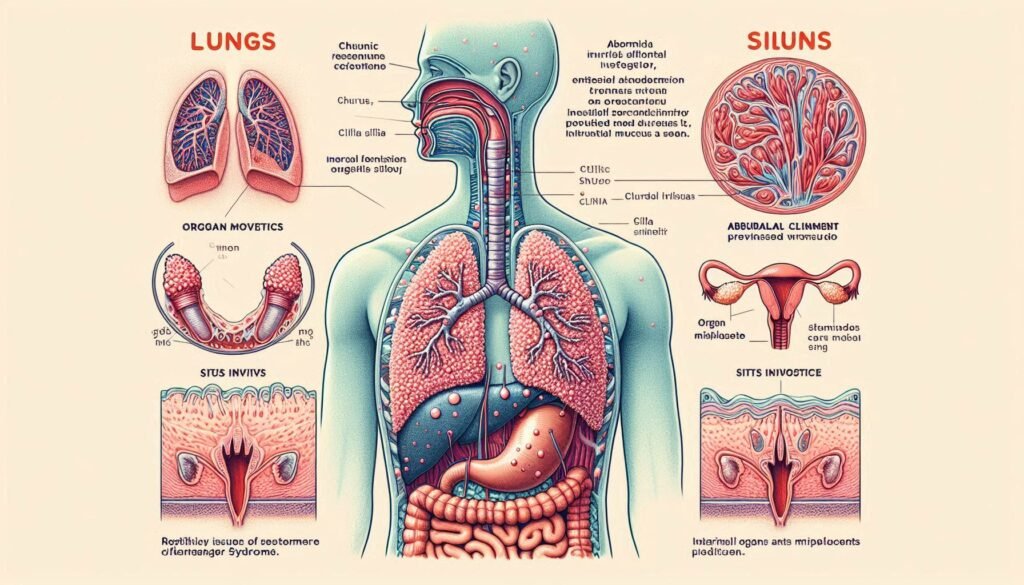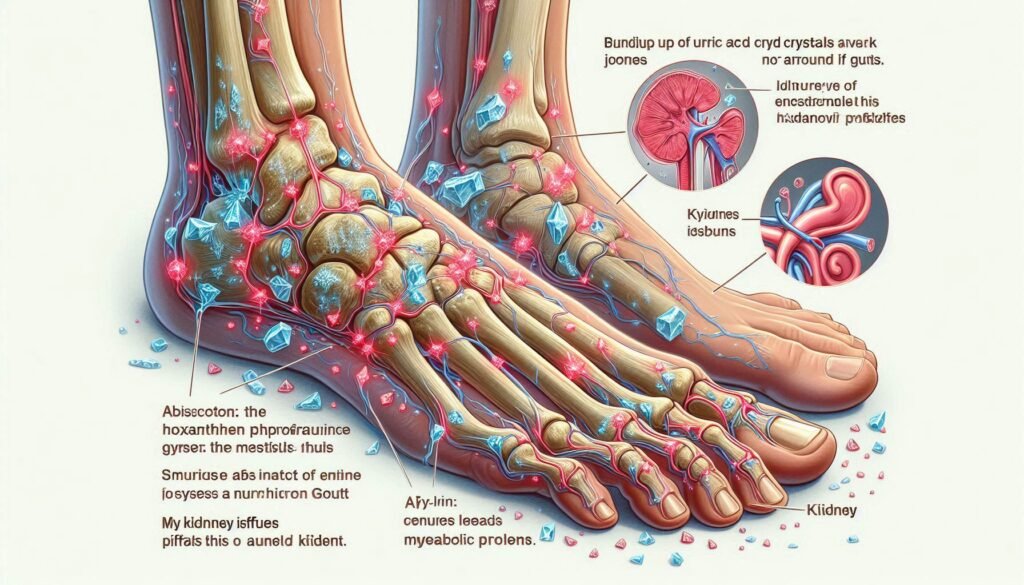Kernicterus syndrome is a serious condition that arises from untreated jaundice in newborns. This rare but devastating disorder can lead to irreversible brain damage, impacting a child’s development for life. As awareness of jaundice grows, understanding the connection between elevated bilirubin levels and kernicterus becomes crucial for parents and healthcare providers alike.
In this blog post, we will delve into the complexities of kernicterus syndrome—exploring its historical context, risk factors, clinical stages, neurological effects, and much more. By shedding light on this often-overlooked topic, we aim to empower families with knowledge that could make all the difference in their child’s health journey. Join us as we navigate through the intricate relationship between bilirubin and brain health in newborns.

Kernicterus Syndrome Explained: From Bilirubin to Brain Damage
Kernicterus syndrome results from high levels of bilirubin in a newborn’s blood, leading to severe neurological damage. Bilirubin is a yellow pigment produced during the breakdown of red blood cells. While it’s normal for newborns to have elevated bilirubin shortly after birth, excessive amounts can become toxic.
“What Causes Galloway-Mowat Syndrome in Children?”
When untreated, this toxicity affects the brain and central nervous system. The developing neural tissues are particularly vulnerable, resulting in irreversible damage that manifests as kernicterus syndrome.
This condition doesn’t present immediately; symptoms may develop days or weeks after birth. Early detection and intervention are vital to prevent long-term consequences associated with this serious disorder affecting many aspects of a child’s life.
Historical Context: Recognition and Prevention Efforts
Kernicterus syndrome has a significant historical context, rooted in the understanding of neonatal jaundice. In the early 20th century, medical professionals began to recognize the dangers associated with untreated hyperbilirubinemia in newborns.
The introduction of phototherapy in the 1960s revolutionized treatment options and significantly reduced kernicterus incidence rates. This innovative approach utilized light to break down bilirubin levels safely.
“Why Does Gardner Syndrome Cause Multiple Tumors?”
Efforts have continued to improve screening protocols for jaundice during routine newborn assessments. Enhanced awareness among healthcare providers has led to better prevention strategies, ensuring timely intervention when elevated bilirubin levels are detected. These advancements play a crucial role in protecting vulnerable infants from permanent neurological damage.
Pathophysiology: How Bilirubin Affects the Developing Brain
Bilirubin is a yellow pigment produced during the breakdown of red blood cells. In newborns, especially those with jaundice, elevated levels can occur due to immature liver function. This excess bilirubin becomes toxic when it crosses the blood-brain barrier.
“How Does Genitopatellar Syndrome Affect Development?”
Once in the brain, bilirubin can disrupt neuronal development and function. It interferes with neurotransmitter systems and cellular metabolism. This disruption contributes to oxidative stress and inflammation.
As a result, critical areas of the developing brain become vulnerable to damage. The basal ganglia and other regions are particularly affected, leading to potential long-term neurological impairments associated with Kernicterus Syndrome. Understanding this pathophysiology highlights the urgency for timely intervention in affected infants.
Risk Factors for Developing Kernicterus Syndrome
Certain factors increase the risk of developing Kernicterus Syndrome in newborns. Premature birth is a significant risk, as these infants often have underdeveloped livers that struggle to process bilirubin efficiently.
“What Triggers Guillain-Barré Syndrome? Recovery Guide”
Another critical factor is blood type incompatibility between the mother and baby, such as Rh or ABO incompatibility. This condition can lead to elevated bilirubin levels due to increased red blood cell breakdown.
Additionally, breastfeeding difficulties may contribute. Insufficient milk intake can lead to dehydration and inadequate caloric consumption, causing jaundice levels to rise unchecked. Identifying these risks early on is crucial for prevention and timely intervention.
Clinical Stages: From Acute Bilirubin Encephalopathy to Chronic Kernicterus
Kernicterus syndrome evolves through distinct clinical stages. It commonly begins with acute bilirubin encephalopathy, where elevated bilirubin levels affect a newborn’s neurological function. Symptoms may include lethargy, hypotonia, and feeding difficulties.
“Why Does Ganser Syndrome Cause False Answers?”
If left untreated, this condition can progress to chronic kernicterus. At this stage, permanent brain damage occurs due to prolonged exposure to high bilirubin levels. Infants may exhibit more severe symptoms like spasticity and developmental delays.
The transition from acute to chronic forms highlights the critical need for early intervention. Timely recognition and treatment are vital in preventing lasting neurological impairment associated with kernicterus syndrome.
Neurological Manifestations: Movement Disorders and Cognitive Impacts
Kernicterus syndrome can lead to significant neurological manifestations, particularly in movement. Infants may exhibit hypotonia, which is a decreased muscle tone that affects their ability to control movements. As they grow, some may develop spasticity or involuntary movements, complicating motor skills.
“How Does Gaucher’s Syndrome Affect Metabolism?”
Cognitive impacts are equally concerning. Affected children often experience learning disabilities and delayed developmental milestones. These cognitive challenges can range from mild difficulties to more severe impairments.
The extent of these issues varies among individuals. Early identification and intervention are crucial for addressing the needs of children with kernicterus syndrome. Strategies tailored to each child’s unique situation can help improve outcomes significantly.
Auditory Processing Disorders and Hearing Loss in Kernicterus
Kernicterus Syndrome can lead to significant auditory processing disorders. This occurs when elevated bilirubin levels affect the brain areas responsible for hearing and sound interpretation. As a result, children may struggle to process sounds correctly.
Many affected individuals experience varying degrees of hearing loss. This impairment can hinder language development and communication skills, making it challenging for them in social settings. Early detection is crucial to address these issues effectively.
Therapeutic interventions, like auditory training and speech therapy, can help improve outcomes. It’s essential for caregivers to monitor their child’s auditory capabilities regularly and seek professional guidance as needed. Addressing these challenges early on fosters better long-term communication abilities.
Visual Disturbances Associated with Kernicterus Syndrome
Kernicterus Syndrome can lead to various visual disturbances in affected children. These issues stem from bilirubin’s toxic effects on the brain, particularly in areas responsible for processing visual information.
Common visual problems include strabismus, where the eyes do not align properly, and nystagmus, characterized by involuntary eye movements. Such conditions can disrupt depth perception and coordination.
Additionally, some children may experience light sensitivity or difficulty focusing. Early identification and intervention are crucial to managing these challenges effectively. Visual support systems and therapies can significantly enhance quality of life for those impacted by Kernicterus Syndrome.
Dental Enamel Hypoplasia: A Lesser-Known Consequence
Dental enamel hypoplasia is a condition that affects the development of tooth enamel, leading to thin or defective layers. This issue often arises in children with Kernicterus Syndrome due to elevated bilirubin levels during infancy. The impact on dental health can be significant.
Children with this condition may experience increased susceptibility to cavities and sensitivity. The weakened enamel lacks the protective qualities needed for strong teeth, posing challenges as they grow older. Maintaining oral hygiene becomes crucial for these individuals.
Early detection and intervention are essential in managing dental complications associated with Kernicterus Syndrome. Regular dental check-ups help monitor changes and facilitate timely treatments, ensuring better overall oral health outcomes for affected children.
Diagnosing Kernicterus: Clinical Assessment and Laboratory Tests
Diagnosing Kernicterus Syndrome requires a comprehensive clinical assessment. Healthcare providers typically begin by evaluating the infant’s medical history and observing physical symptoms, particularly jaundice levels.
Laboratory tests play a crucial role in confirming high bilirubin levels. Blood tests measure total serum bilirubin and its components, helping to determine the severity of hyperbilirubinemia.
Additionally, doctors may perform a neurological examination to identify any signs of brain damage or dysfunction. Early detection is vital for effective intervention and minimizing long-term consequences associated with this condition.
Neuroimaging Findings in Acute and Chronic Kernicterus
Neuroimaging plays a crucial role in diagnosing and understanding Kernicterus Syndrome. In cases of acute bilirubin encephalopathy, MRI scans often reveal hyperintensities in specific brain regions, particularly the basal ganglia and thalamus. These changes indicate damage due to elevated bilirubin levels.
As the condition progresses to chronic kernicterus, neuroimaging findings may shift. At this stage, structural abnormalities become more pronounced. Evidence of atrophy or cyst formation can be observed on imaging studies.
These abnormalities highlight the long-term impact of untreated jaundice on brain development. Early detection through neuroimaging is vital for managing outcomes effectively and guiding treatment strategies tailored to individual needs.
Prevention Strategies: Newborn Screening and Timely Intervention
Newborn screening plays a crucial role in preventing Kernicterus Syndrome. By measuring bilirubin levels shortly after birth, healthcare providers can identify infants at risk of developing severe jaundice. Early detection is key to effective management.
Timely intervention is essential once high bilirubin levels are identified. Phototherapy is often the first line of treatment, using light to help break down excess bilirubin in the baby’s body. In more severe cases, exchange transfusions may be necessary.
Parents should be educated on recognizing signs of jaundice, such as yellowing skin or eyes in their newborns. Prompt action can significantly reduce the risk of lasting neurological damage associated with untreated kernicterus syndrome.
Treatment Approaches for Acute Bilirubin Encephalopathy
Acute bilirubin encephalopathy is a critical condition requiring immediate intervention. The first line of treatment typically involves phototherapy, where blue light helps break down excess bilirubin in the baby’s skin. This non-invasive method is effective and reduces the need for more invasive procedures.
In severe cases, exchange transfusion may be necessary. This process involves replacing the infant’s blood with donor blood to rapidly lower bilirubin levels and prevent brain damage. It’s often reserved for situations where phototherapy alone does not yield enough improvement.
Additionally, supportive care is crucial during this time. Monitoring vital signs, hydration, and temperature stability ensures that infants receive comprehensive treatment tailored to their needs while managing potential complications effectively.
Managing Chronic Kernicterus: Rehabilitation and Supportive Care
Managing chronic Kernicterus requires a comprehensive approach focused on rehabilitation and supportive care. This can include physical therapy, which helps improve motor skills and coordination in affected children. Tailored exercises are essential for promoting mobility and independence.
Occupational therapy plays a key role as well, assisting children in developing daily living skills. Therapists work closely with families to create strategies that enhance the child’s ability to participate fully in everyday activities.
Additionally, emotional support is crucial for both the child and their family. Support groups can offer valuable resources, connecting families facing similar challenges while fostering an understanding of the condition’s impact on life quality.
Speech and Language Therapy for Communication Challenges
Speech and language therapy plays a crucial role for children with Kernicterus Syndrome facing communication challenges. These therapies focus on improving expressive and receptive language skills, helping children articulate their thoughts effectively.
Therapists employ various techniques tailored to individual needs, including play-based activities that encourage interaction. This approach not only enhances speech clarity but also boosts social skills essential for everyday communication.
Additionally, augmentative and alternative communication (AAC) methods may be introduced if verbal expression remains difficult. Through consistent support, children can gain confidence in their ability to communicate, fostering independence as they navigate the world around them.
Educational Considerations for Children with Kernicterus Syndrome
Children with Kernicterus Syndrome often face unique educational challenges. These can stem from cognitive impairments, learning disabilities, or sensory processing issues. Teachers must be aware of the individual needs of each child to create an effective learning environment.
Incorporating individualized education plans (IEPs) is essential. This ensures tailored instruction that addresses specific strengths and weaknesses. Collaboration between educators and parents can foster strategies for academic success.
Support services, such as speech therapy or occupational therapy, play a crucial role in enhancing communication and daily living skills. Creating a supportive classroom atmosphere helps build confidence and encourages social interaction among peers while accommodating sensory sensitivities common in these children.
Long-term Prognosis and Quality of Life Issues
The long-term prognosis for individuals with Kernicterus Syndrome varies significantly. Many factors influence outcomes, including the severity of initial symptoms and the timing of treatment. Early intervention can improve neurological function, but some children may still face challenges.
Quality of life issues are common among those affected. Movement disorders, cognitive impairments, and sensory deficits often persist into adulthood. This can impact daily activities and overall independence.
Support systems play a crucial role in enhancing quality of life. Access to rehabilitation therapies and educational resources can help individuals meet their developmental milestones while fostering social integration within their communities. Creating an inclusive environment is essential for empowering those living with Kernicterus Syndrome.
Legal and Ethical Aspects: Medical Negligence and Patient Rights
Kernicterus syndrome raises significant legal and ethical concerns surrounding medical negligence. When jaundice in newborns goes untreated, healthcare providers may be held accountable for failing to diagnose or manage the condition effectively. Parents often seek justice when they learn that timely intervention could have prevented serious consequences.
Patient rights play a crucial role in these discussions. Families deserve informed consent regarding treatment options and potential risks associated with high bilirubin levels. Educating parents about symptoms of jaundice is essential for early detection.
Legal avenues exist for families affected by kernicterus syndrome. Many pursue compensation through malpractice claims, emphasizing the importance of proactive healthcare practices and proper monitoring during neonatal care to ensure better outcomes for infants at risk.
Current Research: Neuroprotective Strategies and Novel Treatments
Research into Kernicterus Syndrome is evolving rapidly. Scientists are exploring neuroprotective strategies that could mitigate brain damage caused by elevated bilirubin levels. One promising avenue involves antioxidants, which may help neutralize oxidative stress associated with hyperbilirubinemia.
Additionally, novel treatments are being investigated to enhance the effectiveness of current therapies. These include pharmacological interventions aimed at reducing bilirubin toxicity and improving neurological outcomes. Clinical trials continue to assess new drugs and methods for better management of acute bilirubin encephalopathy.
As our understanding deepens, it holds great potential for preventing long-term effects in affected children. Continued research efforts aim not only to improve treatment options but also to provide insights into better screening practices and early intervention protocols for newborns at risk of developing Kernicterus Syndrome.


